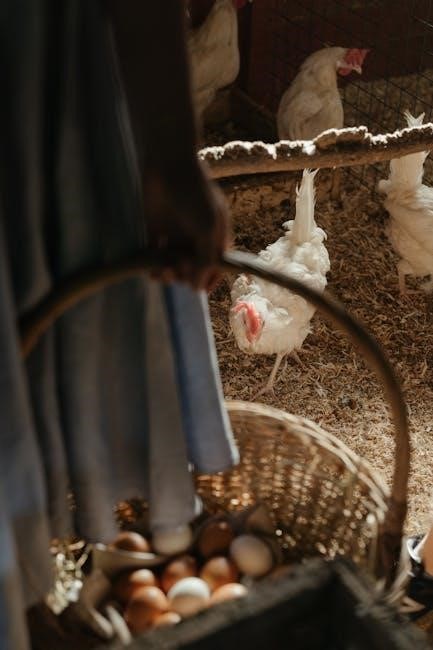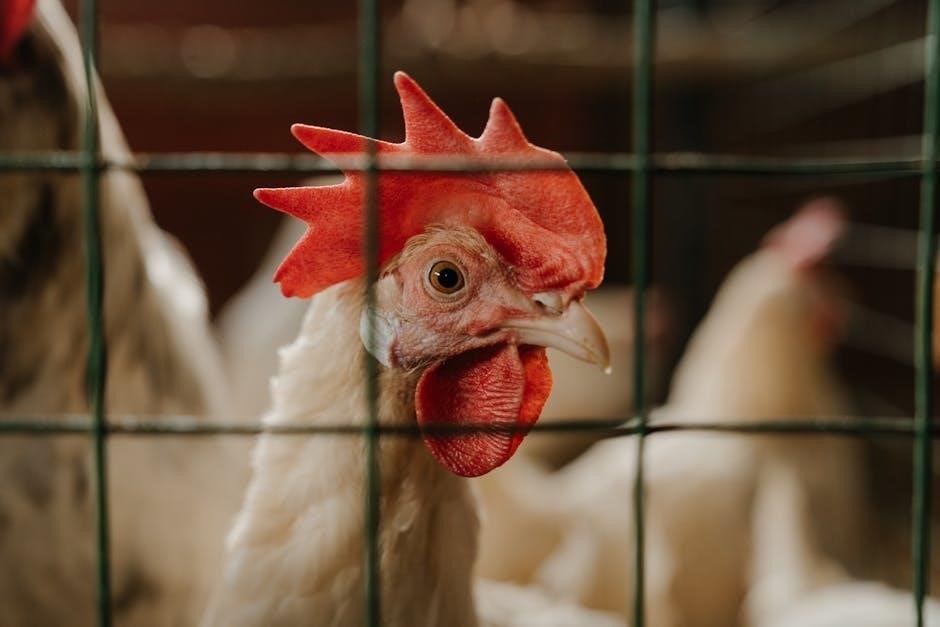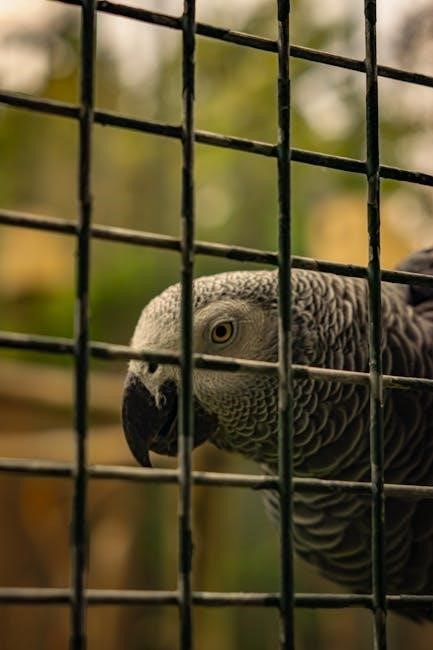Maya Angelou’s poem, I Know Why the Caged Bird Sings, explores themes of freedom, confinement, and racial inequality through vivid imagery and powerful symbolism, resonating deeply with readers worldwide.
Overview of the Poem
Maya Angelou’s poem I Know Why the Caged Bird Sings is a poignant exploration of freedom, confinement, and the African American experience. The title, inspired by a line from Paul Laurence Dunbar’s poem Sympathy, highlights the central metaphor of a caged bird yearning for liberation. The poem contrasts the caged bird’s fearful trill with the free bird’s joyful song, symbolizing the oppression faced by African Americans and their enduring hope for freedom. Through vivid imagery and emotional depth, Angelou portrays the struggle for equality and the resilience of the human spirit. The poem’s structure, written in free verse, allows for a raw and personal expression of these themes. Its powerful message has made it a cornerstone of American literature, resonating with readers and inspiring reflection on racial inequality and the universal desire for freedom.

Significance of the Title
The title I Know Why the Caged Bird Sings holds profound significance, drawing from Paul Laurence Dunbar’s poem Sympathy, which includes the line, “I know what the caged bird feels.” Maya Angelou adopts this imagery to symbolize the African American experience, where the caged bird represents oppression and the free bird embodies freedom. The title encapsulates the poem’s central theme of longing for liberation and the enduring hope for equality. It also reflects Angelou’s personal journey, as the caged bird mirrors her own struggles with racial discrimination and identity. The title’s power lies in its universality, allowing readers to connect with the deeper human desire for freedom and the resilience of the spirit. Through this title, Angelou invites readers to reflect on the historical and emotional dimensions of confinement and the enduring quest for liberation.

Historical Context
Maya Angelou’s I Know Why the Caged Bird Sings is deeply rooted in the historical context of the African American experience during the civil rights movement of the 1960s. The poem reflects the struggles of racial inequality and the longing for freedom, drawing parallels to the collective journey of Black Americans. Angelou’s work was influenced by the literary and cultural movements of her time, including the Harlem Renaissance, which emphasized Black identity and resilience. The poem also resonates with the legacy of slavery and segregation, as the caged bird symbolizes the confinement of oppression, while the free bird represents the aspirations of a marginalized community. By blending personal narrative with broader historical themes, Angelou created a powerful statement that continues to resonate with the fight for equality and justice. The poem’s historical significance lies in its ability to capture the essence of a nation’s turmoil and the enduring hope for liberation.

Poetic Structure and Style

Maya Angelou’s I Know Why the Caged Bird Sings features a fluid, expressive structure, blending simple language with profound depth, while its rhythmic cadence and vivid imagery evoke emotional resonance and authenticity.
Stanza Analysis
Maya Angelou’s poem I Know Why the Caged Bird Sings is structured into concise, evocative stanzas that amplify its emotional depth. The first stanza introduces the central metaphor of the caged bird, its “fearful trill” reflecting longing for freedom. Subsequent stanzas contrast the caged bird’s confinement with the free bird’s soaring, emphasizing the pain of restriction and the joy of liberation. Each stanza builds on the previous, creating a rhythmic flow that mirrors the bird’s yearning. The use of simple yet powerful language allows readers to connect deeply with the bird’s plight, making the poem both personal and universal. Angelou’s stanzas skillfully balance imagery and emotion, drawing parallels between the bird’s experience and broader themes of racial inequality and resilience, ensuring the poem’s enduring impact.
Rhyme and Meter
Maya Angelou’s I Know Why the Caged Bird Sings features a consistent rhyme scheme, typically following an ABAB pattern, which adds a lyrical quality to the poem. The meter is predominantly iambic, with each line consisting of eight syllables, creating a rhythmic flow that mirrors the bird’s yearning for freedom. This structure enhances the emotional weight of the poem, as the regularity of the rhyme and meter contrasts with the irregularity and pain of the caged bird’s existence. The use of end rhymes like “still” and “hill” emphasizes key themes, while the meter maintains a steady, almost hypnotic pace, drawing readers into the bird’s plight. Angelou’s mastery of rhyme and meter allows the poem to resonate musically, making it both memorable and impactful. This technical precision underscores the poem’s exploration of confinement and liberation.
Imagery and Symbolism
In I Know Why the Caged Bird Sings, Maya Angelou employs vivid imagery and potent symbolism to convey the struggles of racial inequality and the longing for freedom. The caged bird itself is a powerful symbol, representing the oppressed African American community, while the free bird embodies the elusive dream of liberation. Imagery such as the “fearful trill” and “things unknown but longed for still” evokes a sense of yearning and resilience. The contrast between the confined bird and the open sky underscores the stark reality of freedom denied. Angelou’s use of natural imagery, like the “distant hill,” further amplifies the theme of aspiration and distant hope. These symbolic elements create a profound emotional connection, allowing readers to deeply grasp the poem’s message of struggle and endurance in the face of oppression.

Themes and Messages

The poem explores central themes of freedom vs. confinement, racial inequality, and resilience. It conveys the deep longing for liberation and the strength to endure oppression, inspiring hope and reflection.
Freedom vs. Confinement
The poem vividly contrasts the freedom of an uncaged bird with the confinement of a caged one, symbolizing the liberation of the soul versus the oppression of societal constraints. The caged bird’s fearful trill and longing for unknown things highlight the deep yearning for freedom, while the distant hill echoes its tune, symbolizing the universal desire for escape from captivity. Angelou uses this imagery to reflect the experiences of African Americans, showcasing the struggle between suppressed voices and the unrelenting quest for liberation. The poem not only portrays the physical confinement but also the emotional and psychological barriers that prevent individuals from truly soaring. This duality underscores the resilience of the human spirit in the face of adversity, making the poem a powerful allegory for freedom and confinement.
Racial Inequality
The poem profoundly addresses racial inequality through the metaphor of the caged bird, symbolizing the oppression and marginalization faced by African Americans. Angelou contrasts the confined bird with its free counterpart, reflecting the stark disparities between Black and white experiences. The caged bird’s “fearful trill” and longing for “things unknown” evoke the historical and systemic barriers that have silenced and restricted Black voices. The distant hill, where the bird’s tune is heard, symbolizes the unattainable freedom that Black individuals have longed for. This imagery highlights the deep-seated racial divide and the enduring struggle for equality. By personifying the caged bird, Angelou gives voice to the collective pain of a community, making the poem a powerful indictment of racial injustice and a testament to the resilience of the human spirit in the face of oppression.
Resilience and Hope
The poem masterfully conveys the theme of resilience and hope through the caged bird’s persistent song, despite its confinement. The bird’s “fearful trill” and longing for “things unknown” reveal a deep-seated desire for freedom, symbolizing the human spirit’s ability to endure oppression. The distant hill, where the bird’s tune is heard, serves as a metaphor for the transcendence of suffering and the hope for a better future. Angelou’s portrayal of the caged bird’s unwavering voice highlights the strength found in adversity, showing how even in captivity, the spirit remains unbroken. This resilience is not just individual but collective, offering hope to those who identify with the bird’s plight. The poem becomes a powerful testament to the human capacity to rise above hardship, inspiring readers to hold onto hope even in the darkest times. The caged bird’s song is, ultimately, a celebration of survival and the enduring quest for liberation.

Cultural and Literary Impact
Maya Angelou’s I Know Why the Caged Bird Sings has profoundly influenced civil rights discussions and inspired countless writers, solidifying its legacy as a timeless literary masterpiece.

Influence on Civil Rights Movement
Maya Angelou’s I Know Why the Caged Bird Sings became a powerful anthem for the Civil Rights Movement, resonating with the experiences of African Americans fighting racial inequality. The poem’s vivid imagery of a caged bird yearning for freedom mirrored the oppressive realities faced by Black communities. Its themes of resilience and hope inspired activists and writers alike, offering a voice to the voiceless. Angelou’s work not only reflected the struggles of her time but also galvanized a generation to demand change. The poem’s influence extended beyond literature, becoming a symbol of resistance and empowerment. It continues to be celebrated for its ability to articulate the universal human desire for freedom and equality, making it a cornerstone of the movement’s cultural legacy.
Legacy in Modern Literature

Maya Angelou’s I Know Why the Caged Bird Sings has left an indelible mark on modern literature, inspiring countless writers and readers alike. Its raw honesty and profound exploration of identity, race, and resilience continue to resonate across generations. The poem’s ability to blend personal narrative with universal themes has made it a timeless classic, often studied in schools and universities worldwide. Many contemporary authors have cited Angelou as a source of inspiration, particularly in the realms of poetry and autobiographical writing. The work’s legacy extends beyond literature, influencing music, film, and social justice movements. Its themes of hope and defiance remain relevant today, ensuring its place as a cornerstone of modern literary culture. The poem’s enduring popularity is a testament to Angelou’s skill in crafting a story that transcends time and speaks to the human condition.


